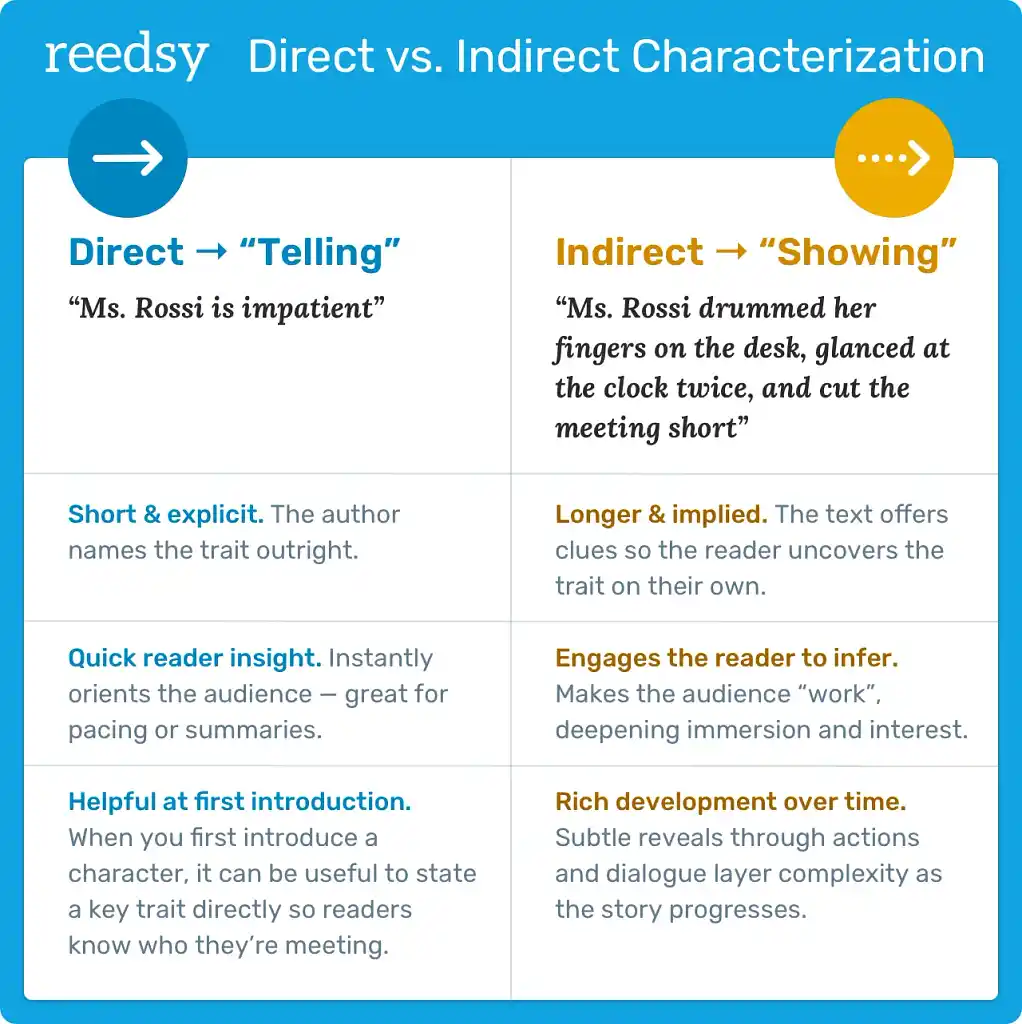Last updated on Jun 25, 2025
Direct Characterization: Definition, Examples, and Tips
Dario Villirilli
Editor-in-Chief of the Reedsy blog, Dario is a graduate of Mälardalen University. As a freelance writer, he has written for many esteemed outlets aimed at writers. A traveler at heart, he can be found roaming the world and working from his laptop.
View profile →Linnea Gradin
The editor-in-chief of the Reedsy Freelancer blog, Linnea is a writer and marketer with a degree from the University of Cambridge. Her focus is to provide aspiring editors and book designers with the resources to further their careers.
View profile →Direct characterization is when the author tells the reader something about a character outright. This approach complements "show, don't tell" characterization (also known as indirect characterization) by adding clarity and efficiency in storytelling.
In this post, we'll draw from plenty of examples to explore what direct characterization is and how to use it effectively alongside indirect methods to sculpt memorable characters for your readers.

FREE RESOURCE
Reedsy’s Character Profile Template
A story is only as strong as its characters. Fill this out to develop yours.
What is direct characterization?
Direct characterization is a literary device whereby an author explicitly tells the reader about a character's appearance, personality, emotions, or background. For example, “John was a towering man with a kind heart.” Instead of relying on inference, this type of characterization establishes character traits unambiguously and concisely, providing readers with important context to understand the character's later actions.
Direct characterization is not only used when introducing characters, but also throughout the narrative whenever there is a need to quickly establish or reinforce something about a main or side character.
Let’s look at a few examples from modern literature.
3 direct characterization examples
In Susanna Clarke’s Piranesi, the amnesiac diarist opens his record with precise facts about his age, height, and build:
I believe that I am between thirty and thirty‑five years of age. I am approximately 1.83 metres tall and of a slender build.
This type of direct description grounds readers in the lone, physical reality of a Piranesi. With this visual baseline established, they can focus their attention on making sense of the mazelike, otherworldly House he inhabits, as Clarke dives into her worldbuilding.
Likewise, in The Goblin Emperor, Katherine Addison (pen name of Sarah Monette) sketches the messenger Csevet in a few strokes, highlighting his unmistakably elvish grace. The description simultaneously shows his status and reveals Maia’s own half-goblin insecurities.
The messenger was maybe a year or so older than Maia himself, but elegant even in his road-stained leathers. He was clearly full‑blooded elvish, as Maia was not; his hair was milkweed‑pale, and his eyes the color of rain.
In The Luminaries, Eleanor Catton introduces newcomer Walter Mood — a cool, analytical observer who has come to sift the mysteries of the New Zealand goldfields — in the following way:
Moody’s natural expression was one of readiness and attention. His grey eyes were large and unblinking, and his supple, boyish mouth was usually poised in an expression of polite concern.

Now, sometimes it can be easier to understand direct characterization by looking at what it’s not. To do so, let’s contrast it with indirect characterization.
Direct vs. indirect characterization
You've probably heard the classic writing mantra: "Show, don’t tell." It’s one of the most common pieces of advice for writers — and it lies at the heart of indirect characterization. Instead of spelling out a character’s traits, it reveals them through their actions, habits, thoughts, and relationships. This enables readers to infer meaning instead of being told, which is often (but not always) a more rewarding experience.
Every attempt at characterization can take either a more direct or indirect approach. Both methods have their place, and most effective character development uses a balance of direct and indirect techniques.
You can think of direct characterization as sketching the outline of a portrait — it defines the essential structure. Indirect characterization, on the other hand, is like adding layers of color, shadow, and texture to bring the subject to life with more depth and nuance.
For example, here’s how the same character trait can be communicated both directly and indirectly:
|
Character Trait |
Direct Characterization |
Indirect Characterization |
|
📱 Physical Appearance (Scarred face) |
"Marcus had a jagged scar running from his left eye to his jaw." |
"He turned his face toward the window, light catching the raised ridge of tissue that transformed his smile into something lopsided and haunting." |
|
⚖️ Values and Beliefs (Commitment to justice) |
"Justice mattered more to Elena than her own safety or career advancement." |
"Elena submitted the evidence against her boss, hand steady as she placed the folder on the detective's desk, though she knew her job wouldn't survive the day." |
|
👋 Habits and Mannerisms (Ring-twirling when stressed) |
"Alex had a nervous habit of twirling his wedding ring whenever he was stressed." |
"As the doctor delivered the diagnosis, Alex's thumb found his gold band, spinning it faster and faster around his finger." |
|
💭 Thoughts (Loneliness despite family) |
"Loneliness consumed Charlotte, even when surrounded by her family." |
"Charlotte smiled at her brothers' jokes across the Thanksgiving table, while mentally rehearsing the quickest route back to her empty apartment." |
|
🌟 Desires and Motivations (Yearning to see the ocean) |
"More than anything, Raj yearned to see the ocean before he died." |
"Raj's apartment walls were covered with seascapes, his bookshelf lined with marine biology texts, though he lived a thousand miles from any coast." |
The pros and cons of direct characterization
Direct characterization is useful because it lets you introduce characters quickly and efficiently, helping you maintain a lively pace. This is particularly true for secondary characters that don’t need the same level of nuance as the story’s protagonists. A single well-placed line of direct characterization can do the work of an entire scene — freeing you to focus on moving your story forward.
Think about it: if you relied solely on showing, aside from losing your mind, your story would likely become unnecessarily long and meandering. At the same time, if you rely too heavily on direct characterization, you risk making the narrative too obvious and, therefore, uninteresting.

Now that we’ve nailed down what direct characterization is and why it’s useful, let’s go over some tips to make the most of it in your writing.
5 tips for effective direct characterization
Direct characterization may be straightforward, but it does not need to feel dull or unimaginative. There are several ways to add style and impact to your direct character descriptions.
Here are some tips:
1. Use sparingly and with purpose
Avoid overwhelming readers with paragraphs of direct character description when they first appear. Instead, weave them in throughout the narrative, revealing traits as they become relevant. If your character's freckles or their childhood in Arizona doesn't influence the plot or character development, consider whether it's worth mentioning.
2. Say more with less
Direct characterization works best when it's efficient. A single, well-crafted sentence often has more impact than a paragraph of description. In Pride and Prejudice, Jane Austen tells a lot about Ms Bennet with this line: “The business of her life was to get her daughters married; its solace was visiting and news.”
3. Support it with “showing”
While direct characterization is explicitly "telling," it should still be supported by scenes that demonstrate these traits in action 一 especially if it’s a core character trait. If you tell readers your character is impulsive, show them making an impulsive decision later.

FREE COURSE
Show, Don't Tell
Master the golden rule of writing in 10 five-minute lessons.
4. Enhance it with literary devices
By using certain literary devices you can transform ordinary direct characterization into memorable descriptions.
For example, using metaphors: "Her ambition was a hungry beast that had devoured her personal life whole." Or creating tension by juxtaposing unexpected elements: "Despite his brutish appearance and reputation as the town's most feared debt collector, Martin wrote poetry with the delicacy of a surgeon and cried during romantic comedies."
5. Be specific and original
Avoid generic descriptions like "she was beautiful" or "he was smart." Instead, focus on specific details: "Her wide-set amber eyes gave her face a feline quality that men found irresistible" or "He could calculate complex equations in his head faster than most people could punch them into a calculator."
Similarly, avoid clichés. Instead of "piercing blue eyes," try something fresh: "His eyes were the faded blue of well-washed denim, somehow both worn and comforting."
Using direct (and indirect) characterization correctly is a skill that takes time to develop. Once you’ve put in the hours, you’ll likely develop an instinct to when and how to use one or the other. Until then, consider working with professional editors to shorten the process of mastering it.
Hire an expert
Lois S.
Available to hire
Editor of nonfiction books for over 30 years. Publishers have consistently trusted me with their most challenging projects.
John H.
Available to hire
College-certified thriller, crime, and historical fiction editor for 10+ years. I believe professionalism and courtesy make projects work.
Stephanie T.
Available to hire
I've worked with some of the biggest names on the NY Times and USA Today Bestsellers lists. I want YOU to be next! Are you ready?
Overall, direct characterization is a powerful tool in your writing arsenal. Learning to use it strategically alongside showing will help you create clearer, more accessible characters while maintaining the narrative nuance that readers crave.






